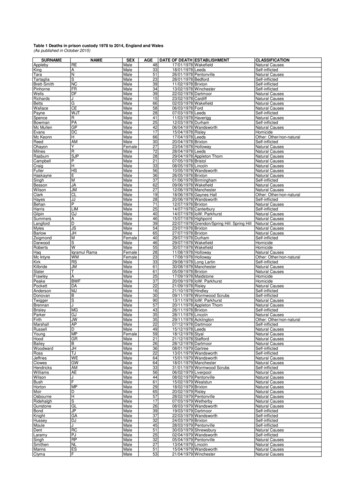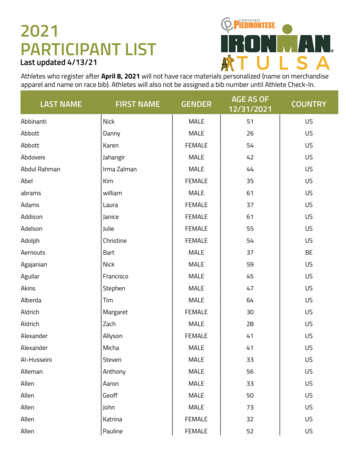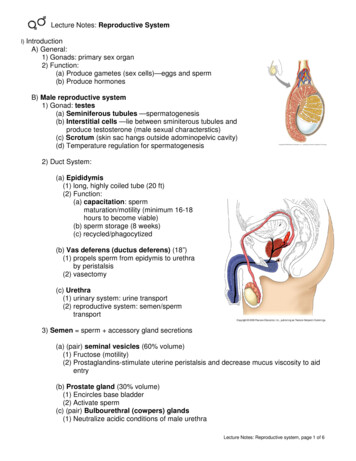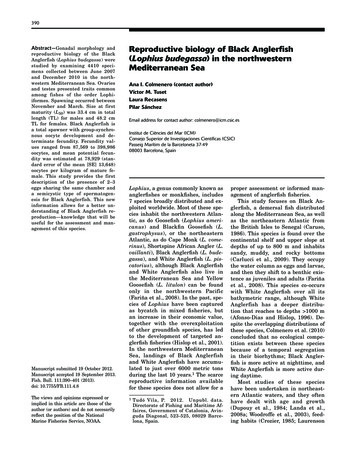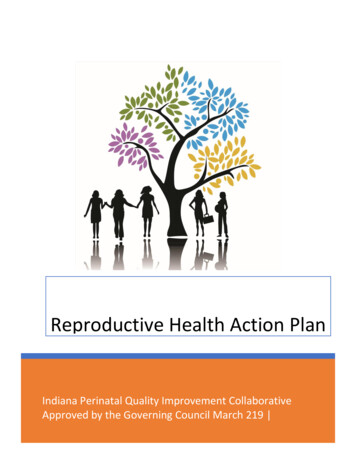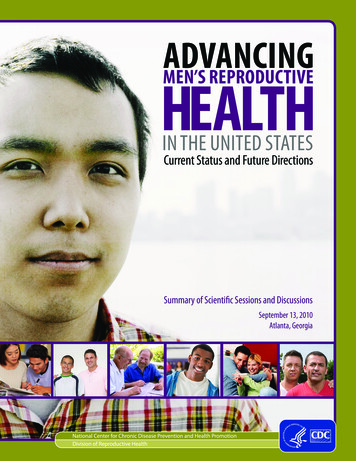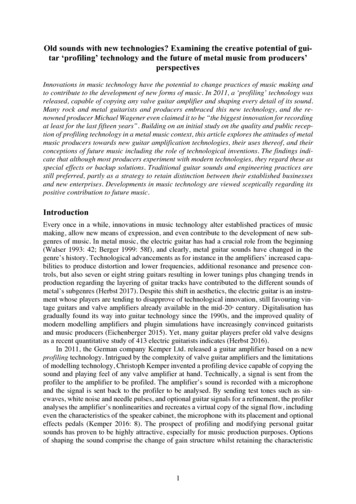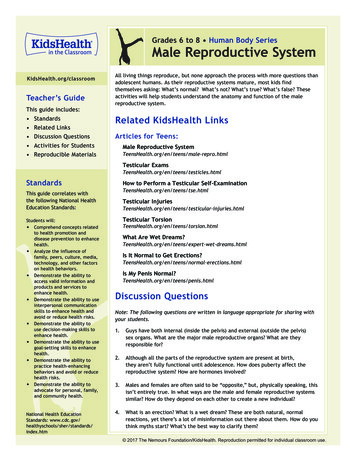
Transcription
Grades 6 to 8 Human Body SeriesMale Reproductive SystemKidsHealth.org/classroomTeacher’s GuideThis guide includes: Standards Related Links Discussion QuestionsAll living things reproduce, but none approach the process with more questions thanadolescent humans. As their reproductive systems mature, most kids findthemselves asking: What’s normal? What’s not? What’s true? What’s false? Theseactivities will help students understand the anatomy and function of the malereproductive system.Related KidsHealth LinksArticles for Teens: Activities for StudentsMale Reproductive System Reproducible esticular rdsHow to Perform a Testicular Self-ExaminationThis guide correlates withthe following National HealthEducation Standards:Testicular InjuriesStudents will: Comprehend concepts relatedto health promotion anddisease prevention to enhancehealth. Analyze the influence offamily, peers, culture, media,technology, and other factorson health behaviors. Demonstrate the ability toaccess valid information andproducts and services toenhance health. Demonstrate the ability to useinterpersonal communicationskills to enhance health andavoid or reduce health risks. Demonstrate the ability touse decision-making skills toenhance health. Demonstrate the ability to usegoal-setting skills to enhancehealth. Demonstrate the ability topractice health-enhancingbehaviors and avoid or reducehealth risks. Demonstrate the ability toadvocate for personal, family,and community health.National Health EducationStandards: en/teens/testicular-injuries.htmlTesticular TorsionTeensHealth.org/en/teens/torsion.htmlWhat Are Wet htmlIs It Normal to Get s.htmlIs My Penis on QuestionsNote: The following questions are written in language appropriate for sharing withyour students.1.Guys have both internal (inside the pelvis) and external (outside the pelvis)sex organs. What are the major male reproductive organs? What are theyresponsible for?2.Although all the parts of the reproductive system are present at birth,they aren’t fully functional until adolescence. How does puberty affect thereproductive system? How are hormones involved?3.Males and females are often said to be “opposite,” but, physically speaking, thisisn’t entirely true. In what ways are the male and female reproductive systemssimilar? How do they depend on each other to create a new individual?4.What is an erection? What is a wet dream? These are both natural, normalreactions, yet there’s a lot of misinformation out there about them. How do youthink myths start? What’s the best way to clarify them? 2017 The Nemours Foundation/KidsHealth. Reproduction permitted for individual classroom use.
Grades 6 to 8 Human Body SeriesMale Reproductive SystemActivities for StudentsNote: The following activities are written in language appropriate for sharing with your students.Male Reproductive SystemObjectives:Students will: Learn the names and functions of parts of the male reproductive systemMaterials: Computer with Internet access“Male Reproductive System” handoutPenClass Time: 20 minutesActivity:A baby boy is born with all the parts of his reproductive system in place. But these parts stay on hold for 9 to 15years – almost like an actor waiting backstage a really long time for his cue. It isn’t until puberty hits that thehormone testosterone kickstarts the reproductive changes that turn a boy into a young man capable of getting a girlpregnant if he has sex. Once it does, a guy starts experiencing all kinds of changes – sexual organ growth, a deepervoice, bigger muscles, body and facial hair, the production of sperm.Let’s take a closer look at the male reproductive system by labeling its parts on the handout and briefly describingtheir functions.Extensions:1.Gametes are the sex cells (egg or ovum for females; sperm for males) that meet in the female’s reproductivesystem to create a new person. Write a paragraph describing the appearance, function, and unique properties ofa sperm cell.2.Create a flowchart that explains the journey of a sperm, from production to ejaculation. Where in the malereproductive system does a sperm cell originate? Where does it go from there?3.Why is it important to protect the health of sexual organs? Discuss some ways males can do this. 2017 The Nemours Foundation/KidsHealth. Reproduction permitted for individual classroom use.
Grades 6 to 8 Human Body SeriesMale Reproductive SystemGuy TalkObjectives:Students will: Use their knowledge of the male reproductive system to correct common misconceptionsMaterials: Computer with Internet access“Guy Talk” handoutPaper and penClass Time: 45 minutesActivity:“Hello friends, this is Dr. Guy Dudeman talking to you live, and today on Guy Talk we’re going to talk aboutwhat some people consider a sensitive subject - the male reproductive system. That’s right, penises, erections,ejaculation, and all that other stuff I know you want to know about. If you’ve got questions, I’ve got answers, so givea call and don’t be shy!”Wow. The phone lines are lighting up. As the intern on the Guy Talk radio show, you’re going to help him preparehis answers. Using the articles at TeensHealth.org for research, compose thoughtful, thorough, and concise tothree of his callers’ questions.Extension:Set up a box by the front of the room and encourage students to write their own anonymous questions and dropthem in. Share some aloud together.Reproducible MaterialsHandout: Male Reproductive male reproductive handout1.pdfHandout: Guy le reproductive handout2.pdfQuiz: Male Reproductive male reproductive quiz.pdfAnswer Key: Male Reproductive male reproductive quiz answers.pdfKidsHealth.org is devoted to providing the latest children’s health information. The site, which is widelyrecommended by educators, libraries, and school associations, has received the “Teachers’ Choice Awardfor the Family” and the prestigious Pirelli Award for “Best Educational Media for Students.” KidsHealth comesfrom the nonprofit Nemours Foundation. Check out www.KidsHealth.org to see the latest additions! 2017 The Nemours Foundation/KidsHealth. Reproduction permitted for individual classroom use.
Human Body SeriesMale Reproductive SystemName:Date:Male Reproductive SystemInstructions: Label the diagram and write the function of each part below.Seminal vesiclesProstate glandBladderUrethraEpididymisVas deferensPenisScrotumTesticles 2017 The Nemours Foundation/KidsHealth. Reproduction permitted for individual classroom use.
Human Body SeriesMale Reproductive SystemName:Date:Guy TalkInstructions: As an intern for the Guy Talk radio show, your job is to help the host answer questions from callers. Choose threeof the questions below, do some research at TeensHealth.org, and write a response that’s both factual and reassuring.“Sometimes I feel like I have the incredible shrinking testicles, especially when it’s cold. Why do they changesize so often?”“I’ve noticed that my penis is smaller than the other guys’ on my team. Is there something wrong with me?What can I do to make it grow?”“I get erections in class when I’m not even thinking about sex! What’s going on? How can I keep this fromhappening?”“I’ve been having so many wet dreams. I even had one at a sleepover. I’ve got to figure out how to controlthem. Any ideas?”“I am uncircumcised and my friend has been telling me that circumcised is better. Is that true?”“If you ejaculate a lot, is it possible to use up your sperm?”“I found a lump in my scrotum. Is this normal?” 2017 The Nemours Foundation/KidsHealth. Reproduction permitted for individual classroom use.
Human Body SeriesMale Reproductive SystemName:Date:QuizInstructions: Answer each question.1.The penis has two main parts: theand the2.“Nocturnal emission” is the medical term for3.What is the fluid that carries and nourishes the sperm?a) urineb) bilec) semend) blood4.The male accessory glands include the5.The duct system is made up of the6.True or false: When semen comes out of the penis, it’s called ejaculation.7.True or false: There are bones in the penis.8.In guys, the physical changes of puberty are caused by the hormone9.Sperm is produced in the:a) testiclesb) vas deferensc) penisd) seminal vesicle.and the.and the.10. Which is not a name for human sex cells:a) spermb) gametesc) semend) ova 2017 The Nemours Foundation/KidsHealth. Reproduction permitted for individual classroom use.
Human Body SeriesMale Reproductive SystemQuiz Answer Keyshaft1.The penis has two main parts: the2.“Nocturnal emission” is the medical term for3.What is the fluid that carries and nourishes the sperm?a) urineb) bilec) semend) blood4.The male accessory glands include theseminal vesicles5.The duct system is made up of theepididymis6.True or false: When semen comes out of the penis, it’s called ejaculation.7.True or false: There are bones in the penis.8.In guys, the physical changes of puberty are caused by the hormone9.Sperm is produced in the:a) testiclesb) vas deferensc) penisd) seminal vesicleglansand thewet dream.prostate glandand theand thevas deferenstestosterone.10. Which is not a name for human sex cells:a) spermb) gametesc) semend) ova 2017 The Nemours Foundation/KidsHealth. Reproduction permitted for individual classroom use.
pregnant if he has sex. Once it does, a guy starts experiencing all kinds of changes – sexual organ growth, a deeper voice, bigger muscles, body and facial hair, the production of sperm. Let’s take a closer look at the male reproductive system by labeling its parts on the handout
